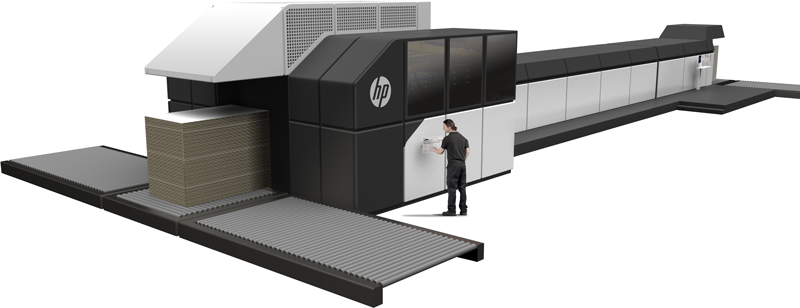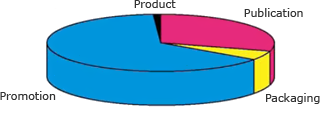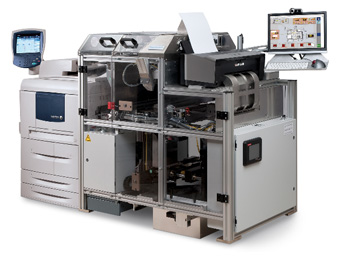Digital printing
Digital printing can be done in various ways. Two technologies dominate the industry:
- Inkjet – In an inkjet printer the image that needs to be printed is created by small droplets of ink that are propelled from the nozzles of one or more print heads. Inkjet devices can print on a wide range of substrates such as paper, plastic, canvas or even doors and floor tiles. Inkjet printing is used a lot for posters and signage. It is also economical for short run publications such as photo books or small runs of books. In-line inkjet printers are sometimes combined with other types of presses to print variable data, such as the mailing addresses on direct mail pieces. The press shown below is the HP PageWide C500, meant for printing on corrugated board.

- Xerography – In xerographic printers, such as laser printers, the image that needs to be printed is formed by selectively applying a charge to a metal cylinder called a drum. The electrical charge is used to attract toner particles. These particles are transferred to the media that is being printed on. To make sure the toner is fixed properly, the substrate passes through a fuser that melts the toner into the medium. Laser printers are not only used in offices but also for small run printing of books, brochures and other types of document. These printers are also used for transactional printing (bills, bank documents, etc) and direct mail.
In 2009 both techniques jointly accounted for around 15% of the total volume of print.
 Digital printing is increasingly utilized for print jobs that were previously printing using offset, flexo or screen printing.
Digital printing is increasingly utilized for print jobs that were previously printing using offset, flexo or screen printing.
- In short run small format (A3 size) printing, digital is taking over from offset for both color and B&W printing. Quick printers and copy shops print digitally on presses from vendors like Xerox, HP, Canon, and Konica Minolta.
- Labels are also increasingly being printed digitally.
- Billboard and point-of-sale or point-of-purchase jobs are being done by wide-format inkjet devices.
- There is a wide range of small format printers used to print on phone cases, mugs and other products.
- In book printing publishing companies start to rely more on print-on-demand. The Espresso Book Machine pictured below is well suited for that job.

There are a number of other digital printing processes that are geared towards specific niche markets:
- Dye-sublimation is a printing process in which heat is used to transfer a dye onto the substrate. Dye-sub printers are mainly used for printing on textiles, for proofing and for producing photographic prints. Some printers can print on a variety of materials such as paper, plastic, and fabric.
- In the direct thermal printing process heat is used to change the color of a special coating that has been applied to paper. This process is used in cash registers but also to add markings, such as serial numbers, to products. For this a transparent ink is used that changes color when a laser applies heat to it.
- In the thermal ink transfer printing process heat is used to melt print off a ribbon and onto the substrate. It is used in some proofing devices but seems to be gradually disappearing off the market.

Balans Computers Services was established in 1999 and sells computers and computer peripherals, provides laboratory services for all types of computer malfunctions, provides services in the field of hosting and hosting websites – setting up, designing, promoting and programming websites. Our customers enjoy quality products, a team with skilled and professional experience, favorable and attractive prices. Our level of service is of a high standard. Our customers from all walks of life and from all over the country, including private and business customers from large companies to small businesses.